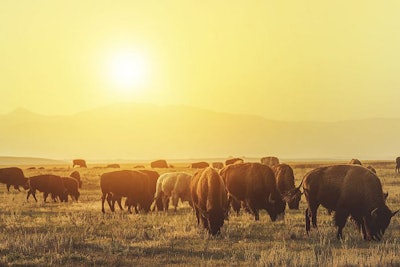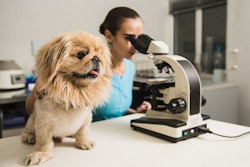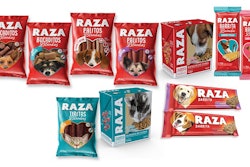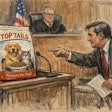
In Petfood Industry’s Pet Food Product Database, 36 pet foods, treats and supplements included American bison (Bison bison) in their descriptions. Bison-based dog, cat and other pet edibles ranged from kibbles and freeze-dried raw diet to treats made from bison by-products like hearts and lungs. Despite marketing efforts disparaging by-products, using the whole animal reduces waste and boosting a products’ environmental sustainability. Similarly, raising bison or other livestock requires land, water, feed and other resources. Bison tend to need fewer inputs from people than cattle. As a native species, the American bison generally cause less environmental damage than introduced cows, sheep and pigs.
After rebounding from near-extinction, bison now provide novel pet food protein. Pet food producers may market bison-meat pet foods as sustainable. Bison remains uncommon in dog and cat foods, so it may also help pet foods stand out on retailers’ shelves and websites.
Growth in the human market for bison meat has led to more people wanting their pets to enjoy bison too, said Dave Carter of the National Bison Association in an earlier article. Incorporating bison in pet foods subsequently helps bison ranchers use all parts of the shaggy mammals.
“The demand for bison in pet food is creating strong demand for hearts and livers as well,” he said.
Bison ranches, conservation, animal welfare and social justice
Bison once ranged from northern Canada to northern Mexico. Bison were neatly hunted to extinction in the 19th century, both to supply a vogue for bison tongue in East Coast cities and as an act of genocide against native peoples, such as the Lakota, by cutting off their food supply. Although bison no longer migrate in herds that stretch from horizon to horizon, they have rebounded.
“In the 1880’s, bison teetered on the brink of extinction, with an estimated 750 remaining in North America,” Carter said. “Today, the North American population is estimated at 400,000 head [in 2017], with more than 90 percent on farms and ranches.”
Although the bison are raised in captivity, ranchers strive to let the animals maintain their natural habits, he said.
For example, bison tend to cause less damage to waterways than cattle. Historically, predators prowled around streams, ponds and other water sources, so bison tend to drink then move away. On the other hand, cattle are more likely to linger on the banks, resulting in erosion and other damages to riparian ecosystems.
Likewise, ranchers tend to avoid some of the practices used in cattle and other livestock that draw the ire of animal rights advocates.
“As a part of that philosophy, we don’t use artificial insemination, castration, or other procedures widely used with domesticated livestock,” he said. “Federal regulations prohibit added growth hormones in bison, and our Code of Ethics prohibit antibiotics to promote growth.
While exterminating bison was once a means to oppress native peoples, modern bison ranchers are working together with Indigenous people to bring back the bison and boost respect for the animals.
“Over the past decade, the National Bison Association has been working closely with tribal nations and conservation groups to promote policies and practices that will bring back bison on all types of landscapes,” Carter said. “The collaboration of the National Bison Association, the Wildlife Conservation Society and the InterTribal Buffalo Council succeeded in winning passage of legislation in 2016 establishing bison as the National Mammal of the United States.
“Now, those groups are continuing to work together on Bison 1 Million, a campaign to bring one million bison back to private, tribal and public lands in North America,” he said.

















